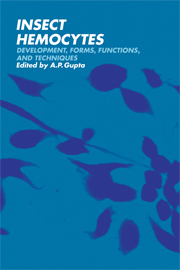Book contents
- Frontmatter
- Contents
- Preface
- List of contributors
- Part I Development and differentiation
- Part II Forms and structure
- Part III Functions
- 11 Hemocytes and growth in insects
- 12 Hemocytes and connective tissue: a critical assessment
- 13 Role of hemocytes in defense against biological agents
- 14 Cellular and humoral responses to toxic substances
- 15 Biochemical and ultrastructural aspects of synthesis, storage, and secretion in hemocytes
- 16 Changes in hemocyte populations
- Part IV Techniques
- Indexes
14 - Cellular and humoral responses to toxic substances
Published online by Cambridge University Press: 04 August 2010
- Frontmatter
- Contents
- Preface
- List of contributors
- Part I Development and differentiation
- Part II Forms and structure
- Part III Functions
- 11 Hemocytes and growth in insects
- 12 Hemocytes and connective tissue: a critical assessment
- 13 Role of hemocytes in defense against biological agents
- 14 Cellular and humoral responses to toxic substances
- 15 Biochemical and ultrastructural aspects of synthesis, storage, and secretion in hemocytes
- 16 Changes in hemocyte populations
- Part IV Techniques
- Indexes
Summary
Introduction
Insects are exposed to the toxins and poisons of their predators as well as to all sorts of chemical poisons. There has been relatively little written on the specific responses of insect hemocytes or hemolymph to poisons. Perry and Agosin (1974) reviewed the physiological responses of insects, resistance in particular, to insecticides. Arnold (1974) has a very short paragraph on detoxication of poisons as a function of hemocytes and concludes that the hemocytes do not function in direct defense against the toxicants. Smith (1962) discussed detoxication mechanisms in insects, but the hemocytes and hemolymph were not included among the mechanisms.
The available literature on this topic is small. I have confined this discussion to responses of hemocytes and hemolymph and have included no other detoxication mechanisms.
Venoms and toxins of predators
Kamon (1965a–d) has done a number of studies on the responses of locusts to scorpion venom. In one experiment (1965a), he injected scorpion venom into locusts, removed the hemolymph, and stored it at 4 °C. After 24 hr of storage there were considerable sediment and opacity in the hemolymph from the venom-treated locusts, but none in the hemolymph of the controls. He found that the increased sediment and opacity were associated with an increase in the specific gravity of the hemolymph and that these phenomena occurred only in treated females. The specific gravity remained high for 14 days, which was the maximum length of the testing period. There was no increase in specific gravity in treated male hemolymph. Kamon could give no explanation for these findings.
- Type
- Chapter
- Information
- Insect HemocytesDevelopment, Forms, Functions and Techniques, pp. 415 - 422Publisher: Cambridge University PressPrint publication year: 1979
- 4
- Cited by

